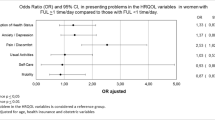Abstract
Purpose
Urinary incontinence (UI) is a common condition in women. The aim of this study is to analyze women with self-reported UI, focusing on socio-demographic data, health-related conditions and comorbidities, and their impact on healthcare resources.
Methods
We analyzed data from a population-based survey with a representative sample of Portuguese women aged ≥ 18 years (n = 10,465). Women with self-reported symptoms of UI were distributed according to age, education level, and household income. The comparison of comorbidities and use of healthcare resources between the UI and non-UI groups was adjusted for age, education, and body mass index. We computed weighted prevalence and adjusted prevalence ratios with 95% confidence intervals using Poisson regression.
Results
Female UI prevalence was 9.9%, increasing with age (6.3% for 18- to 39-year-old, 40.8% for 75- to 85-year-old women). The prevalence decreased with education level (36.8% in women with no education, 4.6% in women with more than 12 years of education) and household income (29.8% in the 2nd quintile of income, 9.9% in the 5th quintile). Women with UI had a higher level of comorbidities, especially cardiovascular, respiratory, and mental health disorders. UI was also associated with higher consumption of healthcare resources.
Conclusion
UI is highly prevalent among Portuguese women. It increases with age, low education level, and low household income. The use of healthcare resources was higher, possibly related with associated comorbidities. Though obtained in a single European country, these data may be useful to design a comprehensive management of UI in other parts of the western world.



Similar content being viewed by others
References
Abrams P et al (2002) The standardisation of terminology of lower urinary tract function: report from the Standardisation Sub-committee of the International Continence Society. Neurourol Urodyn 21:167
Irwin DE et al (2006) Population-based survey of urinary incontinence, overactive bladder, and other lower urinary tract symptoms in five countries: results of the EPIC study. Eur Urol 50:1306
Coyne KS et al (2009) The prevalence of lower urinary tract symptoms (LUTS) in the USA, the UK and Sweden: results from the Epidemiology of LUTS (EpiLUTS) study. BJU Int 104:352
Irwin DE et al (2006) Impact of overactive bladder symptoms on employment, social interactions, and emotional well-being in six European countries. BJU Int 97:96–100
Lai H et al (2015) Correlation between psychological stress levels and the severity of overactive bladder symptoms. BMC Urol 15:14
Balzarro M et al (2019) Impact of overactive bladder-wet syndrome on female sexual function: a systematic review and meta-analysis. Sex Med Rev 7:565–574
Hunskaar S et al (2004) The prevalence of urinary incontinence in women in four European countries. BJU Int 93:324
Hunskaar S et al (2005) Epidemiology of urinary incontinence (UI) and faecal incontinence (FI) and pelvic organ prolapse (POP). In: Abrams P, Cardozo L, Khoury S, Wein A (eds) Incontinence, 3rd edn. Health Publication Ltd, Plymouth, UK, pp 255–312
Coyne KS et al (2009) The burden of lower urinary tract symptoms: evaluating the effects of LUTS on health-related quality of life, anxiety and depression: EpiLUTS. BJU Int 103(Suppl 3):4
Coyne KS et al (2012) Urinary incontinence and its relationship to mental health and health-related quality of life in men and women in Sweden, the United Kingdom, and the United States. Eur Urol 61:88–95
Wagner T et al (2016) Economics of urinary and faecal incontinence, and prolapse. In: Abrams P, Cardozo L, Wagg A, Wein A (eds) Incontinence, 6th edn. Health Publications Ltd, Paris, pp 17–24
Author information
Authors and Affiliations
Contributions
Margarida Manso contributed to data analysis and manuscript writing. Francisco Botelho performed data analysis. Cláudia Bulhões was responsible for project development and data collection. Francisco Cruz wrote the manuscript. Luís Pacheco-Figueiredo was involved in project development and data analysis.
Corresponding author
Ethics declarations
Conflict of interest
The authors have no conflicts of interest to disclose. There is no funding to declare.
Ethics and Informed consent
This survey was approved by ethics committee, and all subjects provided signed informed consent.
Additional information
Publisher's Note
Springer Nature remains neutral with regard to jurisdictional claims in published maps and institutional affiliations.
Rights and permissions
Springer Nature or its licensor (e.g. a society or other partner) holds exclusive rights to this article under a publishing agreement with the author(s) or other rightsholder(s); author self-archiving of the accepted manuscript version of this article is solely governed by the terms of such publishing agreement and applicable law.
About this article
Cite this article
Manso, M., Botelho, F., Bulhões, C. et al. Self-reported urinary incontinence in women is higher with increased age, lower educational level, lower income, number of comorbidities, and impairment of mental health. Results of a large, population-based, national survey in Portugal. World J Urol 41, 3657–3662 (2023). https://doi.org/10.1007/s00345-023-04677-5
Received:
Accepted:
Published:
Issue Date:
DOI: https://doi.org/10.1007/s00345-023-04677-5



